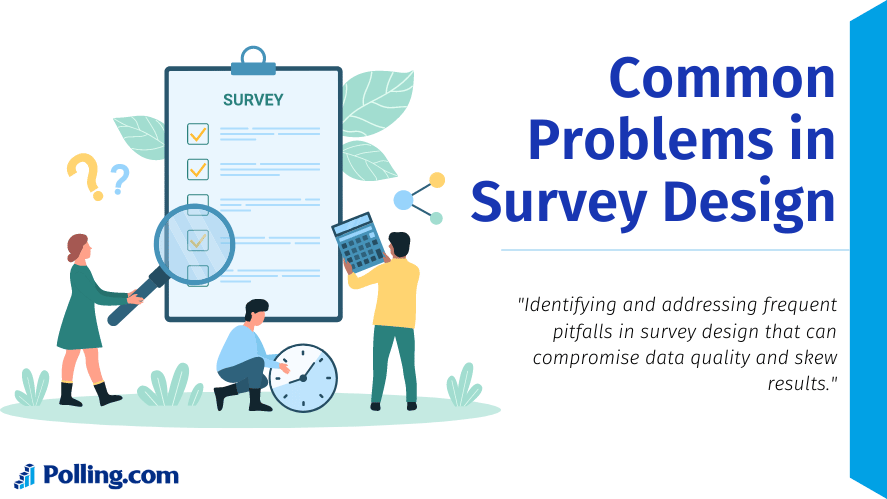
Impact of Survey Design on Data Quality: Best Practices and Case Studies
Surveys help us collect information about what people think, feel, and do. But to get good information, a survey needs to be well-designed. The way a survey is put together can greatly affect the quality of the data it collects.
A survey with poor design can give us bad data. Good survey design, on the other hand, helps us gather accurate and useful information. In this article, we’ll look at how different parts of a survey affect the quality of data.
We’ll also share tips on how to design surveys that collect high-quality data.
1. Parts of a Survey Design

Questionnaire Design
The questions in a survey are the most important part. The phrasing and sequence of questions can significantly influence the responses.
Clear and Fair Questions
Questions should be easy to understand and not lead people toward a specific answer. If a question is unclear, people might not know how to answer it, which can give us bad data.
Rather than asking the general question ‘How frequently do you exercise?” you might ask “On average, how many days per week do you engage in at least 30 minutes of exercise?” This makes it clear and easy for people to answer.
Good vs. Bad Questions
A bad question:
“Do you think the government is doing a good job with the economy?”
This question is leading because it suggests that the government is managing the economy well, which not everyone may agree with.
A better question:
“How would you evaluate the government’s management of economic issues?”
This question is more neutral, allowing people to share their true opinion.
The Importance of Question Order and Format
The order of questions matters. For example, asking about life satisfaction before asking about specific problems can give different results than asking about problems first.
The format of questions is also important. Open-ended questions allow people to give detailed answers but are harder to analyze. Closed-ended questions, where people choose from set answers, are easier to analyze but may not capture all details.
Sampling Methods
Sampling is how we choose who will take the survey. The method used to pick people affects how well the survey represents the larger group.
Different Sampling Techniques
- Random Sampling: Everyone in the group has an equal chance of being selected. This reduces bias and makes the sample more likely to represent the larger group.
- Stratified Sampling: The group is divided into smaller groups based on certain traits (like age or gender), and samples are taken from each group. This ensures that important subgroups are included.
- Cluster Sampling: The group is divided into clusters (like geographic areas), and some clusters are chosen at random to be surveyed. This method is cheaper but can lead to more errors if clusters differ a lot.
Pros and Cons of Each Method
- Random Sampling: Pro—less bias; Con—can be costly.
- Stratified Sampling: Pro—makes sure key groups are included; Con—needs detailed information about the group.
- Cluster Sampling: Pro—cheaper for large areas; Con—can lead to errors if clusters are too different.
How Sampling Method Affects Data Quality
The sampling method can make or break the survey. If we use the wrong method, the data might not represent the whole group. For example, if we only survey people who are easy to reach, the results might be biased and not reflect the true population.
Survey Mode
The way a survey is given—whether online, by phone, face-to-face, or by mail—also affects data quality.
Overview of Different Survey Modes
- Online Surveys: These are done over the internet. They are quick and easy for both the researcher and the respondent. But they may miss people who don’t have internet access.
- Telephone Surveys: These involve calling people and asking them questions. They can reach many people but often have lower response rates because people might avoid unknown callers.
- Face-to-Face Surveys: These are done in person and can get very detailed data, but they are costly and take more time.
- Mail Surveys: These are sent through the postal service. They can reach people who don’t use the internet, but response rates are usually low.
Pros and Cons of Each Mode
- Online Surveys: Pro—fast and cheap; Con—may miss people without internet.
- Telephone Surveys: Pro—interviewers can explain questions; Con—fewer people answer the phone.
- Face-to-Face Surveys: Pro—can get rich data; Con—expensive and slow.
- Mail Surveys: Pro—reaches people without internet; Con—often gets few responses.
How Survey Mode Affects Response Rates and Data Quality
The survey mode influences who responds and how they respond. For example, face-to-face surveys might get more honest answers because of the personal touch, but people might also give answers they think are socially acceptable. Online surveys are quick but might miss older adults or those without internet, leading to biased data.
Survey Length and Complexity
The length and difficulty of a survey can affect how well it is answered.
Impact of Survey Length on Fatigue and Dropouts
Longer surveys can tire people out, leading to lower completion rates and less thoughtful answers. Surveys that take more than 20-30 minutes to complete are especially likely to cause these problems.
Balancing Data Collection with Keeping People Engaged
To keep people interested, surveys should be as short as possible while still gathering the necessary information. Adding progress bars and giving people the option to save and come back later can help keep respondents engaged, even in longer surveys.
2. Common Problems in Survey Design

Nonresponse Bias
Nonresponse bias happens when certain groups of people don’t respond to the survey, which can lead to incomplete or biased data.
Causes and Effects of Nonresponse
Nonresponse can happen for many reasons, such as survey mode, length, or lack of interest. When key groups don’t respond, the survey results may not reflect the whole population, leading to biased data.
How to Reduce Nonresponse Bias
To reduce nonresponse bias, researchers can send reminders, offer rewards, and make the survey as easy to complete as possible. Making the survey relevant to the respondent also helps. Adjusting data after collection (known as weighting) can correct some nonresponse bias.
Response Bias
Response bias occurs when people don’t answer questions truthfully or consistently.
Types of Response Bias
- Social Desirability Bias: People might give answers they think are socially acceptable rather than their true opinions.
- Recall Bias: This happens when people can’t remember past events correctly.
- Acquiescence Bias: Some people might agree with statements regardless of their actual views.
Designing Questions to Reduce Response Bias
To reduce response bias, questions should be neutral and not push people towards a particular answer. Offering a balanced set of response options (e.g., “strongly agree” to “strongly disagree”) and ensuring anonymity can also help.
Sampling Bias
Sampling bias happens when the sample doesn’t represent the population, leading to incorrect results.
Causes of Sampling Bias
Sampling bias can occur when non-random sampling methods are used or when certain groups are hard to reach, such as in online-only surveys.
How to Avoid Sampling Bias
To avoid sampling bias, researchers should use random sampling whenever possible and make sure the sample includes key population segments. Weighting data to reflect population demographics can also help correct for any bias.
3. Best Practices for Better Data Quality in Surveys

Test Your Survey Before Using It
Before using a survey, it’s important to test it to find and fix problems that could lower data quality.
Why Testing Matters
Testing lets researchers see how well questions work and how respondents understand them. It helps identify issues that could confuse people or lead to dropouts, ensuring better data quality.
How to Test Your Survey
Testing can be done with a small group similar to the target population. Feedback from this group can be used to improve questions and survey flow.
Asking participants to explain their thought process when answering can also show how questions are understood and whether any bias exists.
Train and Supervise Interviewers
When surveys involve interviews, the interviewer’s behavior can greatly impact the data collected.
Consistency and Accuracy in Data Collection
Interviewers should be trained to ask questions in the same way each time to avoid inconsistencies. Differences in how questions are asked can lead to differences in responses, affecting data quality.
How Interviewers Affect Data Quality
Interviewers must stay neutral and avoid influencing respondents’ answers. They should also be trained to handle sensitive topics and make respondents feel comfortable, leading to more honest and accurate responses.
Clean and Validate Data
After collecting data, it’s important to clean and validate it to ensure accuracy.
Finding and Fixing Errors in Data
Data cleaning involves checking for and fixing errors, such as inconsistent responses or missing data. Comparing answers to different questions can help find and fix mistakes.
Why Validating Data Matters
Validating responses ensures that the data reflects the intended questions. Missing data should be handled either by filling in the gaps based on other responses or by removing incomplete responses, depending on how much data is missing.
4. Real-Life Examples
Example 1: How Question Wording Affects Survey Results
In a health survey, two versions of a question were tested. One asked, “How concerned are you about your health?” Another question posed was, “How frequently do you find yourself concerned about your health?” The first question led to more reports of concern, showing how small changes in wording can change the answers.
Example 2: The Impact of Sampling Method on Data Quality
A consumer survey used both random sampling and convenience sampling. The random sample matched the population’s demographics, while the convenience sample had more young, urban respondents. This example shows how important it is to choose the right sampling method for accurate data.
Example 3: Survey Mode and Response Rates
An environmental survey was done by mail and online. The mail survey had a lower response rate but included more older adults, while the online survey had a higher response rate but included more younger people. Using both modes gave a more complete picture of people’s environmental attitudes.
5. Conclusion
The design of a survey is a key factor in determining the quality of the data collected. Every choice, from how questions are written to how people are chosen and how the survey is given, can impact the accuracy of the results.
By following best practices—such as testing surveys, training interviewers, and cleaning data—researchers can improve the quality of their surveys and make sure the data they collect is accurate and useful.
For researchers, the lesson is clear: careful survey design is essential for good research. By focusing on strong survey practices, we can collect high-quality data that truly represents people’s views, behaviors, and experiences.
